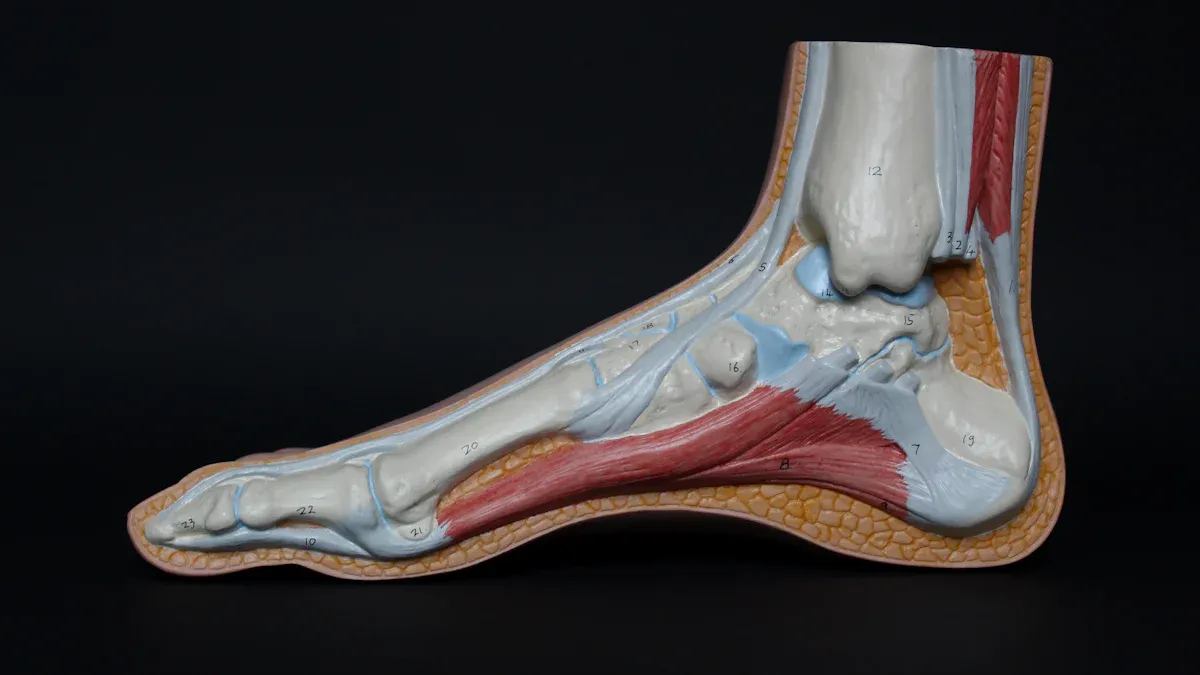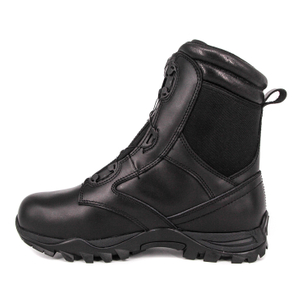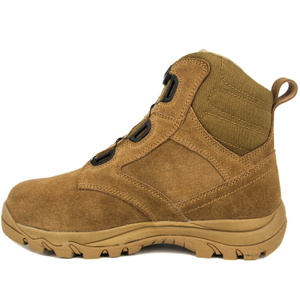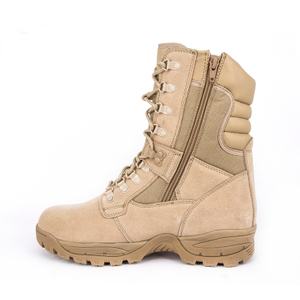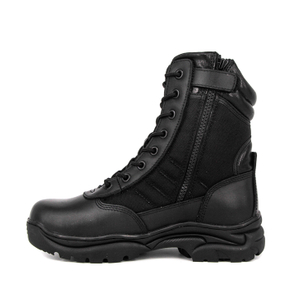You might notice blisters, bunions, plantar fasciitis, ingrown toenails, corns, heel pain, or hammertoes from wearing the Wrong Boot. These problems can make walking tough and slow you down.
Spot symptoms early, choose the right footwear, and look for Milforce boots that care for your feet.
Key Takeaways
Wearing the wrong boots can lead to painful foot issues like blisters, bunions, and plantar fasciitis. Choose boots that fit well to protect your feet.
Look for boots with a wide toe box and good arch support. This helps prevent problems and keeps your feet comfortable throughout the day.
If you notice foot pain, act quickly. Switch to supportive boots and consult a foot doctor if the pain continues.
Common Foot Issues Overview
What Are Common Foot Issues?
You might not realize how many problems can start with the wrong boots. When your boots do not fit right, your feet can develop all sorts of trouble. Here are some common foot issues you might face:
Athlete's foot, which causes itching and a rash
Hammertoes, where your toes bend in a strange way
Blisters, which are painful sores from rubbing
Bunions, a bump on your big toe joint
Calluses and corns, which are thick, sore spots on your skin
Plantar fasciitis, which makes your heel hurt
Claw toe, where your toes curl and rub against your boots
Fungal toenails, which look yellow or thick
Doctors also warn about fractures, sprains, and strains that can happen if your boots do not support your feet. These common foot issues can make walking or standing painful.
Why the Right Boots Matter
Wearing the right boots can help you avoid these problems. Good boots protect your feet and keep them comfortable. Research shows that well-fitted boots can stop calluses from forming and make your feet feel better. Here is what experts say:
Key Findings | Description |
Importance of Proper Fit | Well-fitted shoes can prevent issues such as callus formation and improve comfort, crucial for maintaining foot health. |
Impact on Specific Populations | Shoe fit matters for everyone, especially older adults and people with special needs. |
Role of Education | Learning about shoe choices helps people pick better boots for their feet. |
Milforce cares about your foot health. The company designs boots that fit well and support your feet, so you can avoid many common foot issues.
Blisters from Wrong Boot Fit
Blister Symptoms
You might notice a small bubble on your skin after wearing the wrong boot for a long day. This bubble feels sore and sometimes looks red or swollen. Most blisters show up on your heels, toes, or the sides of your feet.
Blisters are small fluid-filled pockets that form on the outer layer of the skin. They typically develop in response to friction, heat, moisture, or repetitive pressure.
If you feel pain when you walk or see a clear bump, you probably have a blister. Many people get blisters after wearing ill-fitting boots, especially during long walks or hikes.
Causes from Wearing the Wrong Boots
Blisters often start when your foot rubs against the inside of a wrong boot. Here are the most common reasons:
Friction from rubbing against shoes or socks, especially during long walks.
Heat and moisture build up inside the boot, making your skin soft and easy to hurt.
Ill-fitting boots create pressure points and irritate your skin.
You are not alone if you get blisters from the wrong boot. Studies show:
Prevention Tips
You can stop blisters before they start. Try these tips:
Keep your feet clean and nails trimmed.
Pick well-fitting boots that match your foot shape.
Use special sock systems, like wearing two pairs or choosing socks made from different materials.
Try antiperspirants or foot powders to keep your feet dry.
Use barrier methods, such as taping or pads, to protect your skin.
Apply lubricants like Vaseline to reduce friction.
Everyone's feet are different. The best way to prevent blisters is to try different methods and see what works for you. Milforce offers boots designed to fit well and help you avoid the pain of blisters from the wrong boot.
Bunions and Boot Choice
Bunion Signs
You might notice some early signs if you start to develop bunions. These signs often show up when you wear boots that do not fit well. Look out for these clues:
Corns and calluses on your toes or the side of your foot
Redness and swelling around your big toe joint
Tenderness or a burning feeling near your big toe
If you feel pain or see your big toe leaning toward your other toes, you could have bunions starting to form. These signs often get worse if you keep wearing tight or pointed boots.
Wrong Boot Impact
Boots with a narrow toe box can squeeze your toes together. This pressure makes your big toe move toward your second toe. Over time, this causes the joint to stick out, which is what happens with bunions. Research shows that boots with a wide toe box and cushioned soles help take pressure off your toes. When you pick boots that let your toes spread out, you lower your risk of bunions. On the other hand, tight or stiff boots make bunions worse and can cause more pain.
Tip: Always check the shape of the toe box before you buy new boots. Your toes should have room to wiggle.
Prevention and Relief
You can take steps to prevent bunions or make them feel better. Try these ideas:
Choose boots with a wide toe box so your toes do not get squeezed.
Pick soft, flexible materials like leather or mesh to avoid rubbing.
Stay away from high heels and pointed toes.
Look for boots made for bunion support if you already have pain.
Use bunion pads or custom orthotics for extra comfort.
Apply ice if your bunions feel sore or swollen.
Milforce designs boots with your comfort in mind. Their wide toe boxes and soft materials help keep bunions from getting worse. If you notice bunion pain, try these tips and talk to a foot doctor for more help.
Plantar Fasciitis and Foot Pain
Plantar Fasciitis Basics
Do you wake up and feel a sharp foot pain in your heel? You might have plantar fasciitis. This problem happens when the thick band of tissue on the bottom of your foot, called the plantar fascia, gets irritated. It can make walking tough and even stop you from enjoying your day. Here are some signs you might notice:
Heel pain, especially in the morning
Pain that gets worse when you walk or run
Tenderness on the bottom of your foot, just in front of your heel bone
Trouble moving your ankle up
Plantar fasciitis is one of the most common causes of foot pain. It can make every step hurt.
Wrong Boot Causes
Wearing the wrong boots can make plantar fasciitis worse. If your boots do not have good arch support, your feet can start to hurt. Here are some ways bad boots can lead to fasciitis:
Inappropriate footwear increases the risk of plantar fasciitis.
Shoes without arch support can cause foot pain, knee pain, hip pain, and even back pain.
Thin, flat soles put extra strain on the plantar fascia, especially if you walk or stand a lot.
If you wear sandals or flip flops, you might notice more foot pain because they do not support your arches. Boots that do not fit well can make plantar fasciitis last longer.
Prevention Steps
You can take steps to stop plantar fasciitis before it starts. Podiatrists suggest these tips:
Measure | Description |
Supportive Footwear | Wearing a wedge or low heel instead of flat shoes reduces tension on the plantar fascia. |
Orthotic Inserts | Using orthotic shoe inserts can ease tension on the plantar fascia by compensating for anatomical differences. |
Stretching Exercises | Engaging in regular stretching exercises helps maintain flexibility and reduce strain on the plantar fascia. |
Try to pick boots with good arch support and a little heel. Stretch your feet and legs every day. If you feel foot pain, rest and use ice. Milforce boots offer support and comfort, helping you avoid plantar fasciitis and keep your feet happy.
Ingrown Toenails from Tight Boots
Ingrown Toenail Signs
You might not notice an ingrown toenail at first, but the signs can show up quickly. Watch for these common symptoms:
Redness around your toenail
Swelling near the edge of your nail
Pain when you touch or press on your toe
Skin that looks deep pink or feels warm
Discharge or pus if the area gets infected
If you see any of these signs, your toenail could be growing into the skin. This can make walking or wearing boots very uncomfortable.
How Wrong Boots Contribute
Tight boots can squeeze your toes together. When your boots are too narrow or press on your toes, your nails do not have space to grow straight. This pressure can force the nail to dig into the soft skin on the side of your toe. Over time, the nail may start to grow abnormally. You might feel pain or see swelling as the nail pushes into your skin. Pointy or stiff boots can make this problem worse, especially if you wear them for long hours.
Tip: Always check that your boots give your toes enough room to move. A wide toe box helps prevent pressure on your nails.
Prevention Advice
You can take simple steps to keep your toenails healthy:
Trim your nails straight across and smooth the edges.
Keep your feet clean and dry every day.
Avoid picking or tearing at your nails.
Check your nails often for any changes.
Choose boots that fit well—not too tight or too loose.
Pick boots made from breathable materials.
Look for a wide toe box so your toes do not get crowded.
Skip high heels and pointy toes when possible.
Wear sturdy boots for activities that might hurt your feet.
Taking care of your nails and picking the right boots can help you avoid painful ingrown toenails. Milforce boots offer roomy toe boxes and breathable designs to keep your feet comfortable and healthy.
Corns and Calluses
What Are Corns and Calluses?
You might spot hard, thick spots on your feet after wearing boots that do not fit right. These spots are called corns and calluses. Corns usually show up as small, round bumps on the tops or sides of your toes. Calluses look bigger and flatter, often on the bottom of your feet. Both can hurt, especially when you walk or press on them.
Here's a quick look at how they differ:
Type | Characteristics |
Corns | Small, round, raised bumps found on the top or sides of toes. |
Calluses | Larger, thicker patches of skin found on the bottom of the feet, typically more flattened in shape. |
Pain | Both can cause pain and discomfort, especially when pressure is applied. |
Did you know? Over 15% of people get corns and calluses from friction caused by ill-fitting boots. Women tend to get them more often than men.
Wrong Boot Friction
Boots that squeeze your toes or rub against your skin can cause these tough spots. You might notice them after long walks, hikes, or even just standing for hours. Here are some common reasons you get corns and calluses:
Tight or narrow boots that press on your toes
Repetitive friction from walking, running, or dancing
Long periods of standing in boots that do not fit well
If your boots do not give your toes enough room, your skin tries to protect itself by getting thicker. That is how corns and calluses form.
Prevention and Care
You can take steps to stop corns and calluses from forming or getting worse. Try these tips:
Wear boots that fit well and give your toes space
Use foam pads or silicone toe sleeves for hard corns
Cushion sore spots with moleskin or special shoe inserts
Soak your feet in warm water and gently rub thick skin with a pumice stone
Apply creams with salicylic acid or urea to soften rough skin
If you find it hard to walk or the pain does not go away, see a podiatrist. Sometimes, you may need special padding or even a doctor's help to trim thick skin.
Choosing boots like those from Milforce, which offer roomy toe boxes and soft materials, can help keep your feet comfortable and free from painful corns and calluses.
Heel Pain and Support
Heel Pain Symptoms
Heel pain can sneak up on you, especially after a long day in boots. You might feel a sharp or stabbing sensation in your heel or the bottom of your foot. This pain usually shows up when you stand, walk, or put weight on your foot. Sometimes, the pain and discomfort make it hard to walk or even stand for a short time. Many people say the pain feels the worst in the morning or after sitting for a while.
You may notice:
Sharp, stabbing pain in your heel
Discomfort when you take your first steps of the day
Trouble standing or walking for long periods
Wearing the Wrong Boots
Wearing the wrong boots is one of the biggest reasons you get heel pain. Boots that do not fit right or do not support your feet can cause a lot of discomfort. When you wear boots with poor support, your feet move in ways they should not. This puts stress on your ankles and calf muscles. Over time, you might develop problems like Achilles tendonitis or plantar fasciitis, which both cause chronic heel pain and discomfort.
Surveys show that almost half of people blame heel pain on wearing the wrong boots or shoes. Many also believe that these boots can lead to plantar fasciitis.
Relief and Prevention
You can take steps to avoid heel pain and discomfort. First, always choose boots that fit well and give your heels the support they need. Look for boots with cushioned insoles and sturdy heels. Try to avoid wearing the wrong boots for long periods. If you feel discomfort, rest your feet and use ice to help with swelling. Stretching your feet and calves every day can also help prevent pain.
Tip: Milforce boots offer great support and comfort, helping you stay active without heel pain.
If you keep having pain and discomfort, talk to a foot doctor. Taking care of your feet now can help you avoid bigger problems later.
Hammertoes and Shin Splints
Hammertoe Signs
You might notice your toes start to bend in a strange way. The middle joint of your toe sticks up, and the tip points down. This is called hammertoe. You may feel pain when you walk or wear boots. Sometimes, you see redness or swelling on your toe. Corns can form on top of the bent toe, which adds more pain. If you ignore these signs, the pain can get worse over time.
Shin Splint Symptoms
Shin splints cause pain along the front of your lower leg. You might feel a dull ache or sharp pain when you walk, run, or stand for a long time. The pain can get worse if you keep wearing improper footwear. Sometimes, your legs feel tired or weak. You may also notice swelling in your shins. If you push on your shin, you might feel even more pain.
Wrong Boot Effects
Improper footwear can lead to both hammertoes and shin splints. Boots that are too tight or too loose make your toes curl or rub against the inside. This causes pain and changes the way you walk. Without good support, your feet and legs work harder. This extra stress leads to pain in your toes and shins. Improper footwear does not protect your feet, so you feel pain every day.
Note: If you feel pain in your toes or shins, check your boots. The wrong fit can cause big problems.
Prevention Tips
You can stop pain from hammertoes and shin splints by choosing the right boots. Look for boots with strong arch support and a roomy toe box. Make sure your boots fit well and do not squeeze your toes. Stretch your feet and legs every day. Rest if you feel pain. Milforce designs boots with ergonomic features to give your feet the support they need. This helps you avoid pain and keeps you moving comfortably.
Conclusion
You deserve boots that protect your foot health every day. Take a look at this table to see why the right fit matters:
Issue | What Happens to Your Feet? |
Forefoot Pain | Ill-fitting boots cause pain and pressure on your forefoot. |
Long-term Change | Bad fit can change your toes and hurt your foot health. |
Toe Box Design | Small toe boxes harm your foot health and break down tissue. |
Choose boots with good foot support. Pay attention to your foot health, and act early if you notice pain. Milforce helps you care for your foot health. If pain continues, talk to a foot specialist. Keep your foot health strong for a happier life.
FAQ
What should you look for when buying new boots?
You want boots with a wide toe box, good arch support, and soft materials. Try them on with your usual socks for the best fit.
How often should you replace your boots?
Check your boots every six months. If you see worn soles, holes, or feel less support, it's time for a new pair.
Can you fix foot pain by changing your boots?
Yes! Switching to well-fitted, supportive boots can help ease pain. If pain stays, talk to a foot doctor for advice.











